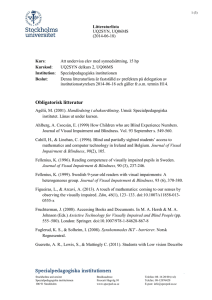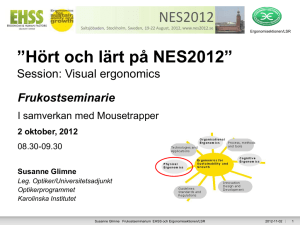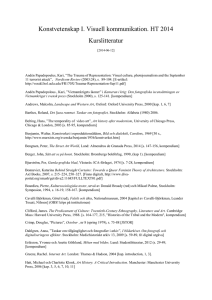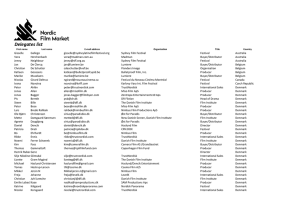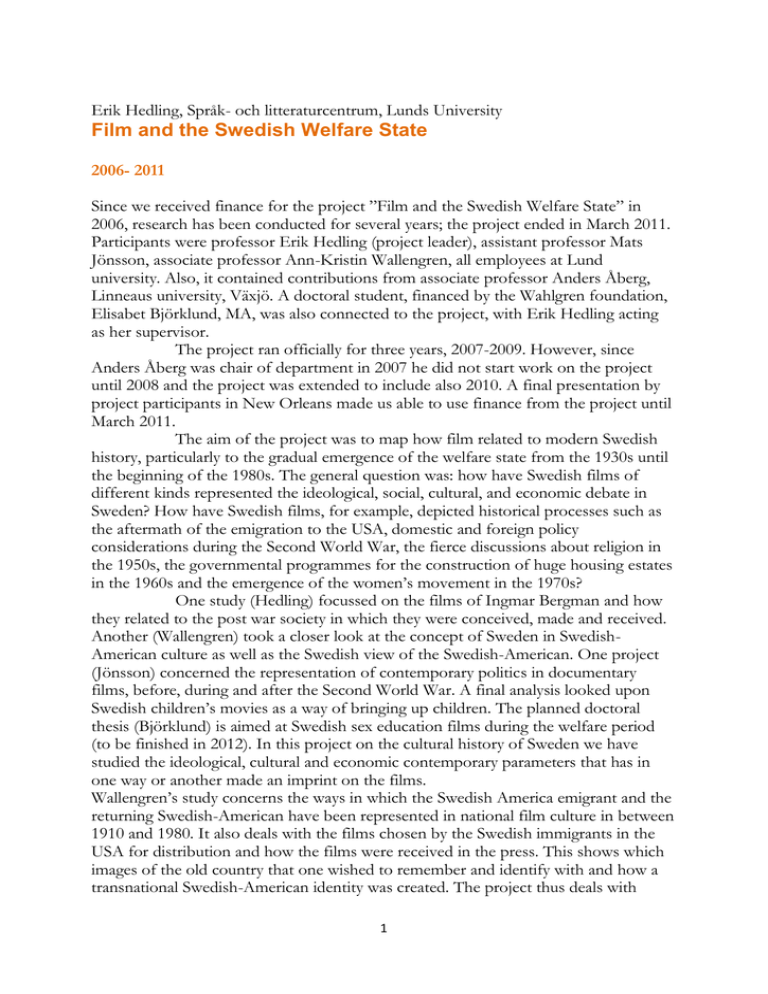
Erik Hedling, Språk- och litteraturcentrum, Lunds University
Film and the Swedish Welfare State
2006- 2011
Since we received finance for the project ”Film and the Swedish Welfare State” in
2006, research has been conducted for several years; the project ended in March 2011.
Participants were professor Erik Hedling (project leader), assistant professor Mats
Jönsson, associate professor Ann-Kristin Wallengren, all employees at Lund
university. Also, it contained contributions from associate professor Anders Åberg,
Linneaus university, Växjö. A doctoral student, financed by the Wahlgren foundation,
Elisabet Björklund, MA, was also connected to the project, with Erik Hedling acting
as her supervisor.
The project ran officially for three years, 2007-2009. However, since
Anders Åberg was chair of department in 2007 he did not start work on the project
until 2008 and the project was extended to include also 2010. A final presentation by
project participants in New Orleans made us able to use finance from the project until
March 2011.
The aim of the project was to map how film related to modern Swedish
history, particularly to the gradual emergence of the welfare state from the 1930s until
the beginning of the 1980s. The general question was: how have Swedish films of
different kinds represented the ideological, social, cultural, and economic debate in
Sweden? How have Swedish films, for example, depicted historical processes such as
the aftermath of the emigration to the USA, domestic and foreign policy
considerations during the Second World War, the fierce discussions about religion in
the 1950s, the governmental programmes for the construction of huge housing estates
in the 1960s and the emergence of the women’s movement in the 1970s?
One study (Hedling) focussed on the films of Ingmar Bergman and how
they related to the post war society in which they were conceived, made and received.
Another (Wallengren) took a closer look at the concept of Sweden in SwedishAmerican culture as well as the Swedish view of the Swedish-American. One project
(Jönsson) concerned the representation of contemporary politics in documentary
films, before, during and after the Second World War. A final analysis looked upon
Swedish children’s movies as a way of bringing up children. The planned doctoral
thesis (Björklund) is aimed at Swedish sex education films during the welfare period
(to be finished in 2012). In this project on the cultural history of Sweden we have
studied the ideological, cultural and economic contemporary parameters that has in
one way or another made an imprint on the films.
Wallengren’s study concerns the ways in which the Swedish America emigrant and the
returning Swedish-American have been represented in national film culture in between
1910 and 1980. It also deals with the films chosen by the Swedish immigrants in the
USA for distribution and how the films were received in the press. This shows which
images of the old country that one wished to remember and identify with and how a
transnational Swedish-American identity was created. The project thus deals with
1
ideology, conceptions of Swedishness and how the films portrayed the emigrants and
how the Swedish-Americans regarded their Swedish origins. A final part analyses how
the Swedish-American woman has been depicted in American cinema, something that
becomes interesting not least in comparison with the construction of the emigrant
woman in Swedish film. To both film cultures concepts like cross dressing, nationality
and ideals become important. The overall aim of the project was to try to understand
the role of Swedish film for the construction of identities at different levels as well as
the production of ideology regarding ethnicity and the identification of the “Other”.
Jönsson’s analysis limits itself to the years surrounding the Second World War. Central
to the study is the notion of “visual education” and the ambition has been to show
who performed the visual education and who was to be educated by it, and why this
visual education was administered at all. Besides specific information regarding
particular images and relations, the research has also managed to isolate new
contextual facts regarding this previously well-researched period in Swedish history. In
all, the results comprise particular and general structures in society as well as details
and messages in specific images. It also provides an insight into how pragmatic
wartime Sweden related to the contemporary development and its use of images and
how openly this fact was acknowledged. The analyses of the success of visual culture
confirm that behind all controlling, advisory and executive agencies there was a
consensus pertaining to party, class and generation borders that can be described as a
submission towards the state in general and towards its visual education in particular.
But the visual education was not only pragmatically implemented by the state; the
citizens also pragmatically received it. This pragmatism was in many cases more
economically and socially motivated than ideologically and politically, a fact that has
been made obvious by the analyses. It was, however, never coincidental or
unconscious. On the contrary, the pragmatism and its visual expression acted and
reacted according to a governmental scheme regarding the visual culture of war that
was carefully staged, supervised and publically implemented. The final point is
therefore that the intense visual education of wartime paved the way for political
imagery in welfare state Sweden also during the following decades.
Åberg has studied children’s films as tools for social conditioning, particularly
regarding films and nationality, that is, how Swedish children’s movies have
represented and reproduced notions, values and feelings pertaining to nationality. The
study has shown a concern regarding Swedish-ness (a problematic entity), which has
been obvious, both in early discussion of children’s film and in the children’s films
themselves during the 1940s.This is an important tendency of children’s films until the
21st century. In the films of the 1940s Swedish-ness was a means of transcending (or
hide) class barriers. During the 1950s and -60s Sweden is often depicted as an idyllic
world. During the 1970s other themes are dominant, but during the 1980s and -90s a
part of Swedish children’s films were characterized by nostalgic reflection on the
cultural heritage. Some films were deeply influenced by romantic aesthetics whereas
others nostalgically showed the welfare society of the post-war years as a period
permeated by a strong national community. This latter phenomenon is finally
connected to the popular notion of the nostalgic people’s home.
Hedling’s study focussed the films of Ingmar Bergman. In opposition to traditional
Bergman research, where aesthetic questions have been predominant, the films were
2
related to the historical development in Sweden during the time in which Bergman was
active as a film director, 1945-1983 (that is, films distributed in the cinemas). Bergman
is the apostate. While film as a whole often put itself in the service of the official
welfare ideology, Bergman created a complex counter-image. The concerns of the
collective here became transformed into the eternal suffering of the individual.
Modernity itself – industrialisation, organisation, urbanisation, secularisation and
cultural diversity – was rejected, and instead an idyllic past was projected. Over his
career, Bergman would fluctuate in between different ideological poles. The
fundamental pessimism regarding the state of man would, however, remain a constant
in his art.
The three most important insights generated by the project could be:
1.
The knowledge that the on-going modernisation of Sweden to a
thoroughly organised welfare state often was represented in the films, not seldom in
the shape of ideological support for the public policies. Swedish children’s movies, for
example, took on the ambitions of the state regarding the bringing up of the coming
generation.
2.
The theory that Ingmar Bergman was an exception in in this regard. His
films instead expressed a critical vision of Swedish post-war society in the 1950s, 60s,
and 70s. Modernity itself was rejected in favour of more conservative flashbacks. The
torments of the soul were more important than material prosperity. It should be noted
that Bergman’s films often came to mix rebellious and reactionary ideologies.
3.
The individual projects all express originality and innovation regarding
Swedish film history. One can here choose to put forward the study of the
representation of America and the Swedish-American in films, a hitherto unexplored
territory within Film Studies. The project as a whole also raises several questions. How
did film, the most popular medium in the 20th century, affect, for example, the
socioeconomic development of the Swedish welfare state? Did film work as a
propaganda weapon for socialdemocratic policies? How did the “nationalisation” of
film come to be in the shape of the film agreement of 1963?
The project has generated a lot of publications, mostly in the shape of academic
articles in English or Swedish, but also many anthologies and monographs. Here, we
choose to emphasise two joint publications as the most important ones, namely
Välfärdsbilder: svensk film utanför biografen (2008), ed. Erik and Mats Jönsson och
Regional Aesthetics: Locating Swedish Media, red. Erik Hedling, Olof Hedling and
Mats Jönsson (2010). Here, project participants as well as other scholars addressed
central questions to the research project as a whole. The first of these anthologies was
given some attention in the Swedish press and television; the second one was written
in English. The project has also had an international part in the shape of many invited
lectures and conference attendances (for example, Erik Hedling 31, Mats Jönsson 26).
All lectures and other activities are listed on the project homepage at
http://project.sol.lu.se/mowis. Also, the project group has organized multiple
workshops, visiting lectures and a large conference in Lund with 250 papers.
Antologier, gästredigerade tidskrifter och monografier (Anthologies and journals)
3
Publications
Björklund, Elisabet, Sexual Education on Film in Sweden (kommande 2012)
Hedling, Erik och Mats Jönsson, red. Välfärdsbilder: svensk film utanför biografen,
Mediehistoriskt arkiv 5, Stockholm: Statens ljud- och bildarkiv, 2008 (455 s + två
DVD-filmer) (Images of Welfare: Swedish Film Outside the Cinema)
Hedling, Erik, guest editor. Film International, vol. 6, no. 5, "Swedish Cinema: New
Wave or Just a Ripple" (Bristol: Intellect Books, 2009)
Hedling, Erik, Olof Hedling och Mats Jönsson, red. Regional Aesthetics: Locating
Swedish Media, Stockholm: Kungliga biblioteket, 2010
Hedling, Erik och Mats Jönsson, guest editors, Special Feature Issue: Film and
History, Scandia: Tidskrift för historisk forskning, Årgång 2010, band 76, häfte 2
Hedling, Erik, Ingmar Bergman and the Swedish Model Welfare State (kommande)
Mats Jönsson och Pelle Snickars, red. Medier och politik: Om arbetarrörelsens
mediestrategier under 1900-talet, Stockholm: Statens ljud och bildarkiv, 2007 (Media
and Politics: The Media Strategies of the Labour Movement in the 20th century)
Mats Jönsson och Patrik Lundell, red. Media and Monarchy in Sweden, Göteborg:
Nordicom, 2009
Mats Jönsson, Visuell fostran: Film- och bildverksamheten i Sverige 1939-1945, Lund:
Sekel förlag, 2011
Wallengren, Ann-Kristin, Film, migration, identitet: Sverige, Amerika och
svenskamerikanen", Lund: Nordic Academic Press, 2012 (kommande)
Åberg, Anders, Svensk barnfilm (kommande)
Erik Hedling: Bokkapitel och uppsatser i referee-granskade tidskrifter (Book chapters
and articles in refereed journals)
"Ingmar Bergman and the Welfare State", Film International, vol. 4, no. 1, s. 50-59
(före projekttiden men genererad av ansökan till RJ)
"Flicka i regnrock: Ingmar Bergman och Vietnam-rörelsen", Vetenskapssocieteten i
Lund: Årsbok 2007, red. Valeria Molnar et al., s. 23-43. (Girl in a Raincoat: Ingmar
Bergman and the Vietnam Movement
4
"Ingmar Bergman, moderniteten och välfärdsstaten: Några kontextuella betraktelser",
Möten: Festskrift till Anders Palm, red. Karin Nykvist et al., Lund: Anacapri Förlag,
2007, s. 395-404 (Ingmar Bergman, Modernity and the Welfare State: Some Contextual
Remarks)
"Lidman mot Bergman. Striden om Skammen 1968", Då och där, här och nu.
Festskrift till Ingemar Oscarsson, Magnus Nilsson, Per Rydén och Birthe Sjöberg, red.,
Lund: Absalon, 2007, s. 211-218 (”Lidman versus Bergman: the Battle of Shame”
"Studentikosa amatörer: den lundensiska karnevalsfilmen 1908-2006" (tillsammans
med Tommy Gustafsson), Välfärdsbilder: svensk film utanför biografen,
Mediehistoriskt arkiv 5, red. Erik Hedling och Mats Jönsson, Stockholm: SLBA, 2008,
s.118-141 (Student Amateurs: The Carnival Films in Lund 1908-2006)
"Inledning: välfärdstecken i tiden" (tillsammans med Mats Jönsson), Välfärdsbilder:
svensk film utanför biografen, red. Erik Hedling och Mats Jönsson, Stockholm: SLBA,
2008, s. 7-29 (Introduction: Contemporary Signs of Welfare)
"The Welfare State Depicted: Post-Utopian Landscapes in Ingmar Bergman's Films",
Ingmar Bergman Revisited: Performance, Cinema and the Arts, ed. Maaret Koskinen,
London: Wallflower/Columbia University Press, 2008, s. 180-193.

Förord: "Nils Krok, Victor Sjöström och Ingeborg Holm", Nils Krok, Ingeborg
Holm, Umeå: Atrium Förlag, 2008, s. 5-11 (Introduction: Nils Krok, Victor Sjöström
and Ingeborg Holm”)
"Shame: Ingmar Bergman's Vietnam War", Nordicom Review: Journal from the
Nordic Information Centre for Media and Communication Research 29 (2008) 2, s.
245-259
"The Arn Franchise: Launching a Small Country Blockbuster", Film International,
vol.6, no. 5, s. 60-67
"Ingmar Bergman och 'dom svarta': några nedslag i jazzmusikens betydelser", Theorier
om verklig diktning: En Festskrift till Per Erik Ljung, red. Erik Hedling et al. Lund:
Absalon, 2008, s. 339-347 (Ingmar Bergman and the ’Blacks’: reflections on the
Meaning of Jazz)
"Konsten att inte sopa problemen under mattan: Ingmar Bergmans Scener ur ett
äktenskap", 1973: En träff med tidsandan, red. Marie Cronqvist, Lina Sturfelt &
Martin Wiklund, Lund: Nordic Academic Press, 2008, s. 71-84 (The Art of Not
Sweeping the Dust Under the Carpet”)
"Breaking the Swedish Sex Barrier: Painful Lustfulness in Ingmar Bergman's The
Silence", Film International, vol. 6, no. 6, s. 17-27
5
"Om filmtolkningens mysterier – Ingmar Bergman och Vietnam-rörelsen", NordicomInformation 31:1 (2009), s. 113-127 (On the Mysteries of Film Interpretation – Ingmar
Bergman and the Vietnam Movement”
"Omaka par: Ingmar Bergman och välfärdsstatens professionella" (tillsammans med
Anna Meeuwisse), Den berusade båten, red. Ros-Mari Eliasson-Lappalainen, Anna
Meeuwisse & Alexandru Panican, Lund: Arkiv, 2009, s. 175-186 (Strange Bedfellows:
Ingmar Bergman and the Welfare State Professionals”
"On the Rocks: The Scanian Connection in Ingmar Bergman's Early Films", Regional
Aesthetics: Images of Sweden, Swedish Imagery, red. Erik Hedling, Olof Hedling och
Mats Jönsson, Stockholm: Kungliga biblioteket och London: Wallflower, 2010, s. 3+7322
"Mapping the Regional: An Introductory Note" (tillsammans med Olof Hedling och
Mats Jönsson), Regional Aesthetics: Locating Swedish Media, red. Erik Hedling, Olof
Hedling och Mats Jönsson, Stockholm: Kungliga Biblioteket och London: Wallflower,
2010, s. 9-19
"Ingmar Bergman and Modernity: Some Contextual Remarks", Swedish Film: An
Introduction and Reader, red. Mariah Larsson och Anders Marklund, Lund: Nordic
Academic Press, 2010., s. 219-228.


"Folkhemmets förnedrare: Om socialassistenter och läkare i Bergmans filmer"
(tillsammans med Anna Meeuwisse), Motsträviga synsätt: Om rörliga bilder som
bjuder motstånd, red. Margareta Rönnberg och Karolina Westling, Göteborg:
Filmförlaget, 2010, s.7-22 (Welfare State Humiliation: On Social Workers and Doctors
in Bergman’s Films”
"Meet the Pioneers: Early Lindsay Anderson'", Shadows of Progress: Documentary
Film in Post-War Britain, ed. Patrick Russell and James Piers Taylor, Basingstoke:
Palgrave MacMillan, 2010, s. 313-327. (jämförande studie av den brittiske
filmregissören Lindsay Anderson och bl a Ingmar Bergman)
Mats Jönsson: Bokkapitel och uppsatser i referee-granskade tidskrifter (Book chapters
and articles in refereed journals)
”Inledning” (med Pelle Snickars), Medier och politik: Om arbetarrörelsens
mediestrategier under 1900-talet, red. Mats Jönsson och Pelle Snickars, Stockholm:
Statens ljud- och bildarkiv, 2007. (Introduction)
”’Den kungliga skölden’ – Per Albin Hansson, Gustaf V och medierna 1940”, Medier
och politik: Om arbetarrörelsens mediestrategier under 1900-talet, red. Mats Jönsson
och Pelle Snickars, Stockholm: Statens ljud- och bildarkiv, 2007 (The Royal Shield: Per
Albin Hansson, Gustaf V and the Media in 1940)
6
”'-Ånej, medborgare!', Per Albin Hansson och politikens medialisering”, Paketerad
politik, red. Mats Ekström och Åsa Kroon, Stockholm: Carlssons, 2007 (Oh No
Citizens. Per Albin Hansson and the Mediatization of Politics)
"Inledning: välfärdstecken i tiden" (med Erik Hedling), Välfärdsbilder: svensk film
utanför biografen, red. Erik Hedling och Mats Jönsson, Stockholm: Statens ljud- och
bildarkiv, 2008 s. 8-29 (Introduction: Contemporary Signs of Welfare)
"Visuell fostran: Barnens Dag i Sverige under andra världskriget", Välfärdsbilder:
svensk film utanför biografen, red. Erik Hedling och Mats Jönsson, Stockholm:
Statens ljud- och bildarkiv, 2008, s. 142-165 ( Visual Education: The Day of the Child
in Sweden During the Second World War)
"Marcimainstream? History in Two Contemporary Swedish TV-series", Film
International, vol.6, no. 5, s. 36-41
"Family Matters: The Bernadottes and the 1940 Defence Loan", Media and Monarchy
in Sweden, eds. Mats Jönsson and Patrik Lundell, Göteborg: Nordicom, 2009
"Media and Monarchy: An Introduction", Media and Monarchy in Sweden, eds. Mats
Jönsson and Patrik Lundell, Göteborg: Nordicom, 2009
"'En gynnsam jordmån för suggestiv påverkan'", Årsbok 2009, Lund:
Vetenskapssocieteten i Lund, 2009 (Sound Soil for Suggestive Influence)
"Performative Nature – The Nature of Sweden in Arne Sucksdorff's Wartime
Documentaries", Beyond the Visual - Sound and Image in Documentary and
Ethnographic Film, red. Gunnar Iversen and Jan Ketil Simonsen, Højbjerg:
Intervention Press, 2010
"Lund: Open City? Swedish Municipal Mediation 1939–1945", Regional Aesthetics:
Locating Swedish Media, red. Erik Hedling, Olof Hedling och Mats Jönsson,
Stockholm: Kungliga biblioteket, 2010
"Locating the Regional: An Introductory Note" (med Erik Hedling och Olof Hedling,
Regional Aesthetics: Locating Swedish Media, red. Hedling, Hedling och Jönsson,
Stockholm: Kungl. biblioteket, 2010, red.
"Neutral Nazism? Swedish–German Film Relations 1941–1945", Scandia: Tidskrift för
historisk forskning, Temanummer "Film and History", vol 76, nr 2, 2010, red. Erik
Hedling och Mats Jönsson.
"Introduction: Film and History", (med Erik Hedling), Scandia: Tidskrift för historisk
forskning, Temanummer "Film and History", band 76, häfte 2, 2010, red. Erik
Hedling och Mats Jönsson.
7
"Introduction: Documentary Filmmaking in Sweden" Swedish Film: An Introductory
Reader, red. Mariah Larsson och Anders Marklund, Lund: Nordic Academic Press,
2010
"Vart tog Lund och Skåne vägen? Om platsens icke-betydelse i en reklamfilm för
Tetra Pak", Skåne, mat och medier, red. Helena Sandberg, Lund: Skånes
livsmedelsakademi, 2010 (Where Did Lund and Skåne Go? About the Lack of
Meaning of Place in a Commercial for Tetra Pak)
Ann-Kristin Wallengren: Bokkapitel och uppsatser i referee-granskade tidskrifter
(Book chapters and articles in refereed journals)
”Svenskhet i diasporan – nationell film och den svenskamerikanska pressen” i Då och
där, här och nu. Festskrift till Ingemar Oscarsson 2007, Lund: Absalon, 2007, s. 33-45
(Swedishness in the Diaspora: National Film and the Swedish-American Press)
”På besök i det gamla hemlandet: amerikaemigranternas återvändarfilmer” i
Välfärdsbilder. Svensk film utanför biografen, red. Erik Hedling och Mats Jönsson,
Stockholm: Statens ljud- och bildarkiv, 2008, sid 320-334 (Visiting the Old Country:
The Films of Returning America Emigrants)
”Hollywood in Sweden: Cinematic References Imagining America" i Film
International vol 6., no 5, s. 42-49
"’John Ericsson: Victor of Hampton Roads’. Images of Sweden in American History”.
Erik Hedling, Olof Hedling and Mats Jönsson, eds. Regional Aesthetics: Locating
Swedish Media, Stockholm: Kungliga biblioteket, 2010, s. 63-81
Celebrating Swedishness. Swedish-Americans and Cinema. Anders Marklund och
Mariah Larsson, eds. Swedish Film. An Introduction and Reader, Lund: Nordic
Academic Press, 2010 s. 134-144.
” Importing Evil: The American Gangster, Swedish Cinema, and Anti-American
Propaganda”. Kingsley Bolton, and Jan Olsson, eds. Media, Popular Culture, and the
American Century, Stockholm: Kungliga biblioteket, 2010, s. 216-227
”Småland-Amerika tur och retur: Filmen och smålänningen”. Inger Littberger CaisouRousseau, Maria Nilsson och Carina Sjöholm, red. Speglingar av Småland, Hestra:
Isaberg förlag, 2009, s. 249-269 (Småland-America There and Back: People from
Småland in Film)
Anders Åberg: Bokkapitel och uppsatser i referee-granskade tidskrifter (Book chapters
and articles in refereed journals)
8
"Vacanza all'isola dei gabbiani : La creazione e la diffusione di un paradiso estivo
svedese". Infanzia. 2009, 409-413 (Holiday on the Island of Seagulls: The Creation and
Distribution of a Swedish Summer Paradise)
"Seacrow Island: Mediating Arcadian Space in the Folkhem Era and Beyond".
Regional Aesthetics: Locating Swedish Media, red. Erik Hedling, Olof Hedling och
Mats Jönsson, Stockholm: National Library of Sweden, 2010, s. 125-140.
"Remaking the National Past: The Uses of Nostalgia in the Astrid Lindgren Films of
the 1980s and 1990s", in Bettina Kümmerling-Meibauer & Astrid Surmatz eds.,
Beyond Pippi Longstocking: Intermedial and International Approaches to Astrid
Lindgren's Work. London & New York, Routledge. 2011, 73-86
Elisabet Björklund: Uppsatser i referee-granskade tidskrifter (Articles in refereed
journals)
”Cinematic Sex Education in the Twenty-first Century: Narration, Reflexivity, and
Sexuality in Kärlekens språk”(2004), Film International vol. 6, no. 5, s. 27-35
9


